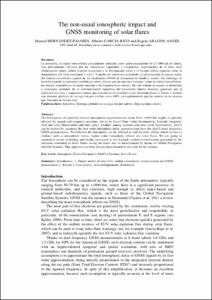Mostra el registre d'ítem simple
Use of GNSS derived ionospheric information to detect and measure Solar Flares
| dc.contributor.author | Hernández Pajares, Manuel |
| dc.contributor.author | García Rigo, Alberto |
| dc.contributor.author | Aragón Ángel, María Ángeles |
| dc.contributor.other | Universitat Politècnica de Catalunya. Departament de Matemàtica Aplicada IV |
| dc.date.accessioned | 2015-04-10T10:49:47Z |
| dc.date.available | 2015-04-10T10:49:47Z |
| dc.date.created | 2014-12 |
| dc.date.issued | 2014-12 |
| dc.identifier.citation | Hernandez, M.; Garcia-Rigo, A.; Aragon-Angel, M.A. Use of GNSS derived ionospheric information to detect and measure Solar Flares. "Física de la Tierra", Desembre 2014, vol. 26, núm. 2014, p. 81-87. |
| dc.identifier.issn | 0214-4557 |
| dc.identifier.uri | http://hdl.handle.net/2117/27247 |
| dc.description.abstract | The Ionosphere, the partially ionized atmospheric r egion ranging from approximately 60 to +1000 km height, is typically affected by spatial and tempor al variations, driven by Local Time (solar illumina - tion), Latitude (magnetic field and solar illuminat ion) and time (space weather, among seasonal and solar cycle dependence). It can be indirectly studi ed from the dual L-band frequency GNSS measure- ments by assuming the first order ionospheric delay approximation (the higher order ionospheric effects in GNSS typically constitute less than 0.1% of the overall ionospheric effect and only affects very precise applications). Moreover, the Ionospher e is affected as well by ionospheric waves, ,solar flares and other space weather effects. Recent mode ling techniques and corresponding results are going to be summarized regarding to the daylight su dden overionization generated by the radiation associated to Solar Flares facing the Earth, and it s measurement by means of Global Navigation Satellite Systems. This approach has already been i mplemented in real-time by the authors. |
| dc.format.extent | 7 p. |
| dc.language.iso | eng |
| dc.publisher | Universidad Complutense de Madrid (UCM) |
| dc.rights | Attribution-NonCommercial-NoDerivs 3.0 Spain |
| dc.rights.uri | http://creativecommons.org/licenses/by-nc-nd/3.0/es/ |
| dc.subject | Àrees temàtiques de la UPC::Matemàtiques i estadística::Matemàtica aplicada a les ciències |
| dc.subject.lcsh | Geophysics |
| dc.subject.lcsh | Astronomy and astrophysics |
| dc.subject.other | Ionosphere |
| dc.subject.other | Global Navigation Satellite Systems |
| dc.subject.other | Solar Flares |
| dc.title | Use of GNSS derived ionospheric information to detect and measure Solar Flares |
| dc.type | Article |
| dc.subject.lemac | Física matemàtica |
| dc.subject.lemac | Geofísica |
| dc.contributor.group | Universitat Politècnica de Catalunya. IonSAT - Grup de determinació Ionosfèrica i navegació per SAtèl·lit i sistemes Terrestres |
| dc.description.peerreviewed | Peer Reviewed |
| dc.subject.ams | 85 Astronomy and astrophysics |
| dc.subject.ams | 86 Geophysics |
| dc.relation.publisherversion | http://revistas.ucm.es/index.php/FITE/article/view/46973 |
| dc.rights.access | Open Access |
| local.identifier.drac | 15414830 |
| dc.description.version | Postprint (published version) |
| local.citation.author | Hernandez, M.; Garcia-Rigo, A.; Aragon-Angel, M.A. |
| local.citation.publicationName | Física de la Tierra |
| local.citation.volume | 26 |
| local.citation.number | 2014 |
| local.citation.startingPage | 81 |
| local.citation.endingPage | 87 |
Fitxers d'aquest items
Aquest ítem apareix a les col·leccions següents
-
Articles de revista [3.267]
-
Articles de revista [87]


